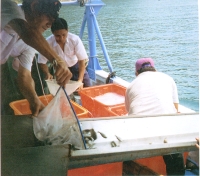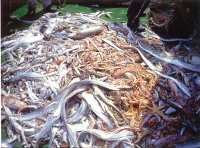|
Fish KM
|
|

|
|
Notice Board
|
|
|
|
|
|
Home > Fish KM > Fisheries research
The techniques of sea ranching in Taiwan

From:FA Location:Taiwan

The release of black porgy larvae. | 
Harvest of Deep-water Investigation in South China Sea. |
In order to develop the sea ranching in Taiwan, stock enhancement technology fishery production. This practice has been used by the Taiwan Fisheries Research Institute sine 1989.
1‧Finfish
(1) Studies on the evaluation of black porgy releasing (Acanthopagrus schelegeli) 4.3 million Sparidae fry have been released in Taiwan since 1978. Among them, about 3.7 million were black porgy. By analyzing the annual harvest it was Determined that the fishing season had been extended, the exploitation rate increased as well as a gradual stock increase.
(2) Studies on eels releasing
20 metric tons (approximately 38,262 individual) adult eels were released in Taiwan from 1976 to 1995. The released eels were 2+ to 3+ years old. There was a ratio of 1:3 female eels per kilogram, while the ratio for male eels was 3:4 per kilogram. They were released in the waters of southwestern Taiwan.
2‧Shellfish
Small ablone (Haliotis aquatilis), hard clam (Meretrix lusoria), purple clam (Soletellina diphos) and freshwater clam (Corbicula fluminalis) were cultivated. Results on the efficiency of small abalone are as follows: The growth rate in summer was about 2mm to 8mm per month, and 1mm in winter. Currently, about 4.8 million small abalones have been released. The recapture data found that mortality was caused by fishing during the early stages of maturation. Therefore, controls on shell fishing and water pollution must be implemented and enforced otherwise, the sea ranching of the samll abalone will be fruitless.
3‧Shrimps
Sand shrimp (Metapenaeus ensis), grass prawn (penaeus monodon), Kuruma prawn (P. japonicus) and bear prawn (P. semislcatus) were cultivated. 322 million shrimp fry had been released in waters off Taiwan since 1975. The recapture data indicated that they moved within 4km from their release point and their life span was about 1.5 years. This proved that restocking of fry for cultivation was quite promising.
|